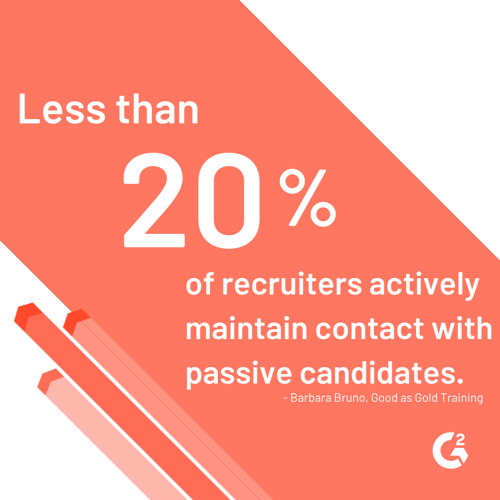Does your new employee pipeline seem to have run dry? The problem could be that you’re not looking in the right places.
As a recruiter, if you’re only focusing on candidates who are actively seeking a new role, you are likely missing out on the huge untapped potential of passively interested candidates.
Active vs. passive interest
Candidates with active interest are seeking out new employment opportunities by applying to organizations or contacting recruiters. Candidates with passive interest are currently employed and not seeking out new opportunities directly but still may be open to a change.
Seeking out candidates with passive interest is key if you want the best new employees for your company. Since these people are usually harder to recruit, it can be seen by some as a waste of time. Let’s cover a few different points on recruiting candidates with passive interest:
Before we dive in to this recruitment strategy, it’s important to understand exactly what puts people into this box in the first place.
What is passive interest?
A candidate’s interest refers to whether they are actively seeking out new job opportunities or not. Candidates with passive interest are currently employed and typically happy with their jobs. This can make it a challenge to recruit them to join your organization.
Because candidates with passive interest are not actively looking for a new position, recruiting them requires much more persuasion. Your role as a recruiter quickly turns into the role more akin to that of a salesperson.
Are passive candidates worth it?
In selling your employer brand to both active and passive candidates, it’s important to consider what your expected ROI (return on investment) is. How far are you willing to go for a candidate?

When trying to recruit passive candidates, you need to determine how much time and money it will take in order to make a new hire. You also need to determine when it’s time to move on.
Candidates with passive interest tend to be happy in their current roles. Contacting them without having a better offer could lead to them feeling as if they’re being poached and even go as far as creating tension between your two organizations.
Recruiting passive candidates is a huge risk, but, at the end of the day, they could fill the gaps in your headcount better than most passive candidates.
| TIP: Want a centralized way of attracting and contacting candidates? Check out the best recruitment marketing platforms to nurture interest of active and passive candidates. |
Benefits of a passive candidate
Contacting candidates with a passive interest can prove extremely valuable to your hiring needs. For starters, you already know that these people are in a role similar to an opening you’re trying to fill.
As a recruiter, you know that passive candidates are likely to be a good fit since they were able to be hired into their roles at another company. Additionally, hiring one passive candidate could convince other qualified people from their former company to make a move to your organization.
Disadvantages of a passive candidate
Because passive candidates require more work to recruit, it’s not always the most sustainable method of employee sourcing. Successfully placing a passive candidate into an opening requires recruiters to be extremely proactive in order to sway them to consider a new job when they are not active in the job market.
It can often be hard to sell these people on reasons they should make a change, but that doesn’t mean it’s impossible. Keep reading to understand exactly what you can do to catch the attention of a passive candidate.
How to recruit a passive candidate
It’s going to take a bit of strategy and a whole lot of tact in order to get a passive candidate to consider leaving a job they’re content with.
- One of the best places to start looking for passive candidates is on social media websites like LinkedIn and Twitter. In the age of the internet, the information people disclose about themselves online is always up for grabs. Don’t feel slimy about it. All’s fair in love, war, and recruitment.
- After finding a qualified candidate, put yourself in their position. What kind of things would convince you to leave a job you were comfortable at for a new role and company? Develop a value proposition to sell to passive candidates and extend an offer they will have a tough time turning down.
- Make the “sale” by providing exactly what the passive candidate needs to consider this big of a change in their career. Make your case clearly and direct, leaving the ball in their court.
- Nurture the candidate with an occasional follow up, watching for signs of disinterest or backing away. There comes a time when the conversation turns cold and it’s no longer beneficial to continue pursuing the candidate. Even if they don’t apply immediately, the candidate knows the opportunity is a possibility for them in the future.
Recruiting passive candidates isn’t easy, but it can be a little simpler with the right applicant tracking system to organize and contact candidates through a central solution.

Tap into something great
Focusing on the recruitment of candidates with a passive interest is the solution you need to fill your employee pipeline. New talent is only a call or email away.
One of the best ways to meet passive candidates is through networking events. Seem a little daunting? Read this guide on how to network to put your nerves at ease.
 by Preethi Varma
by Preethi Varma
 by Nivedita Joshi
by Nivedita Joshi
 by Mara Calvello
by Mara Calvello